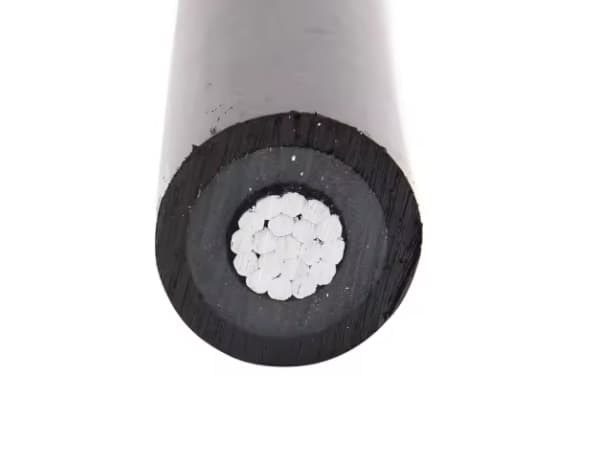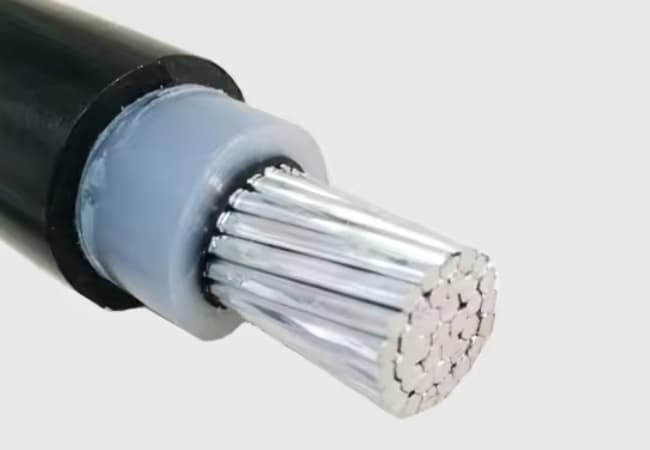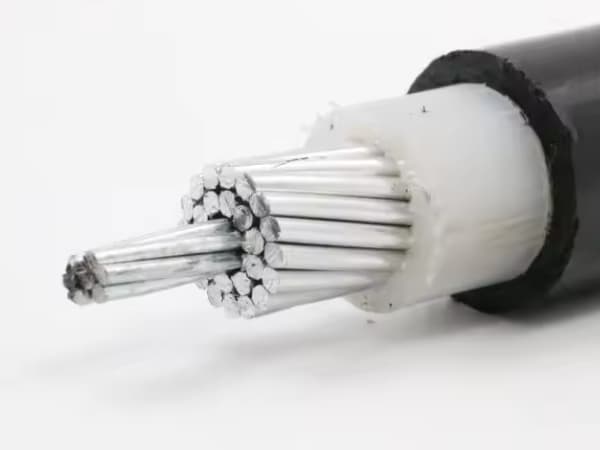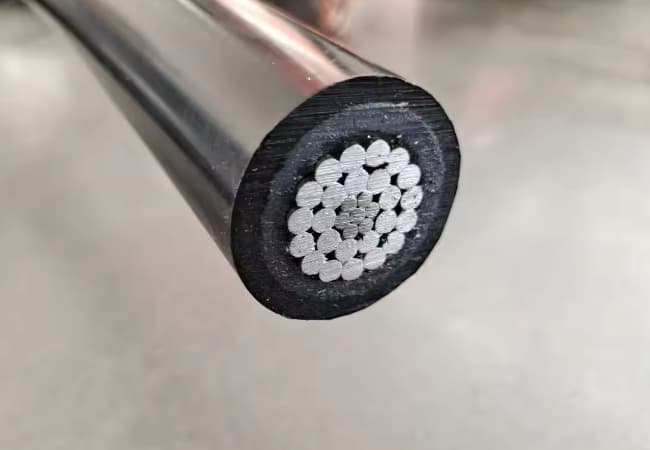
Ağaç Teli , Tutarlı elektriğin modern yaşamın neredeyse her yönü için kritik önem taşıdığı bir çağda, Güç dağıtım sistemlerinin güvenilirliği çok önemli bir rol oynar. Fakat, Geniş ormanlık ve kırsal alanlara elektrik dağıtmak benzersiz zorluklar sunuyor. Havai enerji hatlarının güvenilir kalmasının önündeki en önemli engellerden biri, enerji hatları ve ağaçlar arasındaki etkileşimdir.. Düşen dallar, aşırı büyümüş yapraklar, ve şiddetli rüzgarlar sıklıkla hizmette kesintilere neden olur, ekipman hasarı, ve hatta tehlikeli koşullar.
Bu sorunlarla mücadele etmek için, enerji endüstrisi özel teknoloji geliştirdi, içermek “ağaç teli.” Bu makale ağaç telinin ne olduğunu araştırıyor, önemi, yapı, uygulamalar, avantajlar, ve ormanlık alanlarda enerji dağıtımının geleceğini nasıl şekillendirdiği.
Ağaç Teli Nedir??
Ağaç teli, yoğun bitki örtüsüne sahip alanlarda kullanılmak üzere özel olarak tasarlanmış bir tür havai elektrik telidir.. Ağaç dalları ve diğer yapraklarla doğrudan temasa karşı dayanıklı olacak şekilde tasarlanmıştır., Ağaçların kablolarla temas etmesinden kaynaklanan elektrik kesintisi ve hasar olasılığını azaltır.
Ağaç teli tipik olarak iletkeni ağaç dallarının tele dokunması veya tele düşmesi nedeniyle oluşan elektrik arızalarından koruyan sağlam bir yalıtım katmanına sahiptir.. Bu, özellikle ormanlık veya kırsal bölgelerde etkili olmasını sağlar, geleneksel çıplak iletkenlerin bitki örtüsünün neden olduğu kesintilere karşı daha duyarlı olduğu yerlerde.
Tamamen yalıtılmış yer altı kablolarının aksine, Ağaç teli baş üstü bir çözüm olmaya devam ediyor. Fakat, yarı yalıtımlı tasarımı, daha fazla koruma sağlarken aynı zamanda uygun maliyetlidir, Performansı bütçeyle dengelemek isteyen kamu hizmetleri şirketlerinin tercih ettiği bir seçim haline geliyor.

Ağaç Teli İnşaatı
Ağaç telinin yapısı, çevresel zorluklara direnme ve zorlu koşullar altında bile güvenilir performans sağlama yeteneğinin anahtarıdır. Yapımında yer alan malzemeleri ve katmanları anlamak, ağaç telinin neden bu kadar etkili olduğunu açıklamaya yardımcı oluyor.
1. İletken Çekirdek
Ağaç telinin çekirdeği alüminyumdan veya alüminyum alaşımından yapılmıştır, mükemmel elektrik iletkenliği ve hafiflik özellikleriyle bilinir. Alüminyum korozyona da dayanıklıdır, telin elementlere maruz kaldığı dış mekan uygulamaları için idealdir.
Bazı durumlarda, alüminyum iletken çelik takviyeli (ACSR) kablolar çekirdek olarak kullanılır, çeliğin mukavemetini alüminyumun iletkenliği ve korozyon direnciyle birleştiriyor. Bu daha yüksek çekme dayanımı sağlar, şiddetli rüzgarlara veya potansiyel olarak telin üzerine düşebilecek büyük ağaçlara eğilimli alanlarda çok önemlidir.
2. Yalıtım Katmanı
Ağaç telinin belirleyici özelliklerinden biri yalıtım katmanıdır., genellikle polietilenden yapılır (PE) veya çapraz bağlı polietilen (XLPE). Bu malzemeler dayanıklılıkları ve mükemmel yalıtım özellikleri nedeniyle seçilmiştir.. Elementlere maruz kalmaya dayanacak şekilde tasarlanmıştır, güneş ışığı gibi (UV radyasyonu), yağmur, kar, ve aşırı sıcaklıklar, koruyucu özelliklerini bozmadan veya kaybetmeden.
Yalıtım ayrıca dalların veya diğer nesnelerin tel ile temas ettiğinde elektrik arızalarına neden olmasını önleyen bir bariyer sağlar.. Bu, özellikle elektrik hatlarının etrafında açık bir yolun korunduğu alanlarda önemlidir. (geçiş hakkı yönetimi olarak bilinir) zorlu.
3. Aşınma Direnci
Ağaç teli aşınmaya dayanıklı olacak şekilde tasarlanmıştır, yani ağaç dalları zamanla tellere sürtse bile, yalıtım katmanı kolayca aşınmaz. Bu, tel ile tekrarlanan temastan kaynaklanabilecek kısa devreleri veya arızaları önlemeye yardımcı olur. Yalıtımın aşınma direnci, yoğun ormanlık alanlarda ağaç telinin çıplak iletkenlere göre tercih edilmesinin nedenlerinden biridir.
4. Hava Koşullarına Dayanıklılık ve UV Dayanımı
Ağaç telinin bir diğer önemli özelliği, sert hava koşullarına uzun süre maruz kalmaya dayanma yeteneğidir.. Yalıtımda kullanılan malzemeler ultraviyole ışınlarına karşı oldukça dayanıklıdır (UV) güneşten gelen ışınlar, yalıtımın zamanla kırılganlaşmasını veya çatlamasını önlemeye yardımcı olur. Ağaç teli aynı zamanda aşırı sıcaklıklara dayanacak şekilde tasarlanmıştır, ister yazın yoğun sıcağı olsun ister kışın dondurucu soğuğu.

Havai Güç Dağıtımı için Ağaç Teli Neden Önemlidir?
Ağaç tellerinin temel amacı bitki örtüsünün enerji hatları için önemli risk oluşturduğu alanlarda elektriğin sürekli ve güvenilir dağıtımını sağlamaktır.. Havai enerji hatlarında kullanılan geleneksel çıplak iletkenler ağaçlarla temasa karşı hassastır, elektrik kesintilerine neden oluyor, hasarlı ekipman, ve hatta bazı durumlarda yangınlar bile çıkıyor. Ağaç teli, iletken ile çevre arasında koruyucu bir bariyer sağlayarak bu riskleri en aza indirir.
1. Elektrik Kesintilerinin Önlenmesi
Ağaç tellerinin en önemli faydalarından biri, ağaç dallarının tellerin üzerine düşmesi veya dokunması nedeniyle meydana gelen elektrik kesintilerinin sıklığını azaltma yeteneğidir.. Kırsal ve ormanlık alanlarda, Elektrik hatlarının yakınındaki ağaçların varlığını tamamen ortadan kaldırmak genellikle pratik değildir veya imkansızdır.. Ağaç teli, enerji hatlarının sık sık hizmet kesintisine yol açmadan doğal ortamla bir arada yaşamasını sağlayarak çözüm sunuyor.
2. Geliştirilmiş Güvenlik
Ağaç kablosu aynı zamanda güç dağıtım sisteminin güvenliğini de artırır. Bir ağaç dalı çıplak bir iletkene dokunduğunda, yalnızca hizmeti aksatmakla kalmayıp aynı zamanda çevredeki alan için de tehlike oluşturabilecek bir elektrik arızası oluşturabilir. Bazı durumlarda, bu arızalar elektrik yangınlarına yol açabilir, hızla yayılabilen, özellikle kuru, ormanlık alanlar. Ağaç teli, elektrik arızalarına karşı ek bir koruma katmanı sağlayarak bu tehlikeli durumların önlenmesine yardımcı olur.
3. Uygun Maliyetli Bitki Örtüsü Yönetimi
Açık geçiş haklarının korunması (SIRA) Elektrik hatları etrafında dolaşmak, kamu hizmetleri şirketleri için maliyetli ve emek yoğun bir görev olabilir. Ağaçların elektrik hatlarına müdahale etmesini önlemek için ağaç budama ve bitki örtüsü kontrolü gereklidir, ama bazı bölgelerde, bu çabalar ya pratik değildir ya da düzenli olarak gerçekleştirilmesi mümkün değildir.
Ağaç telleri bitki örtüsü yönetimine daha az agresif bir yaklaşım sağlar. Tel dallarla temasa dayanacak şekilde tasarlandığından, kamu hizmeti şirketleri ağaç kesme çalışmalarının sıklığını ve yoğunluğunu azaltabilir, uzun vadede maliyet tasarrufu sağlar.
Ağaç Tel Kablo Uygulamaları
Ağaç telleri çeşitli ortamlarda kullanılır, her birinin kendine özgü zorlukları ve gereksinimleri var. Telin çevresel faktörlere direnme ve sürekli bitki örtüsü yönetimi ihtiyacını azaltma yeteneği, onu birçok uygulama için çok yönlü bir çözüm haline getiriyor.
1. Kırsal ve Orman Alanları
Ağaç tellerinin en yaygın kullanım alanlarından biri kırsal ve ormanlık bölgelerdedir., Elektrik hatlarının sıklıkla yoğun ormanlık alanlardan geçirilmesinin gerektiği yerler. Bu alanlar, düşen dallar ve diğer döküntülerden kaynaklanan kesintilere karşı özellikle hassastır. Ağaç telleri, bu olayların güç dağıtım sistemi üzerindeki etkisini azaltarak güvenilir bir çözüm sağlar..
2. Fırtınaya Eğilimli Bölgeler
Ağaç kabloları sık fırtınaların yaşandığı bölgelerde de kullanılıyor, kasırgalar gibi, buz fırtınaları, ve şiddetli rüzgarlar. Bu olaylar sırasında, ağaçların ve dalların elektrik hatlarının üzerine düşme olasılığı daha yüksektir, yaygın kesintilere yol açıyor. Ağaç teli, dallar tellerle temas ettiğinde bile arızaları önleyebilecek ekstra bir koruma katmanı sağlayarak bu riski azaltmaya yardımcı olur.
3. Orman Yangını Önleme Bölgeleri
Orman yangınlarının endişe verici olduğu bölgelerde, Ağaç telleri elektrik yangınlarının önlenmesinde önemli rol oynuyor. Ağaç dallarından kaynaklanan elektrik arızası olasılığını azaltarak, ağaç teli, kuru zemine yayılabilecek bir yangının kıvılcımlanma riskini azaltmaya yardımcı olur, yanıcı bitki örtüsü.

Ağaç Tel Kablo Kullanmanın Avantajları
Ağaç tellerine yatırım yapan kamu hizmetleri şirketleri birçok önemli avantaj elde ediyor, geliştirilmiş sistem güvenilirliği dahil, azaltılmış bakım maliyetleri, ve artan güvenlik.
1. Artan Sistem Güvenilirliği
Ağaç tellerinin en acil avantajı, güç dağıtım sisteminin güvenilirliğini artırma yeteneğidir.. Bitki örtüsünden kaynaklanan kesintilerin sayısını azaltarak, Ağaç teli, elektriğin evlere ve işyerlerine tutarlı bir şekilde iletilmesini sağlamaya yardımcı olur, ağaçların bol olduğu bölgelerde bile.
2. Azalan Bakım Maliyetleri
Ağaç kablosu aynı zamanda kamu hizmeti şirketlerinin bakım masraflarından tasarruf etmesine de yardımcı olabilir. Ağaçların hızlı büyüdüğü veya enerji hatlarına erişimin zor olduğu bölgelerde, Düzenli ağaç kesme ve bitki örtüsü kontrolünün maliyeti önemli olabilir. Ağaç teli kullanarak, kamu hizmeti şirketleri bu faaliyetlerin sıklığını azaltabilir, uzun vadeli maliyet tasarrufuna yol açar.
3. Geliştirilmiş Güvenlik
Güvenlik, ağaç telinin bir diğer önemli faydasıdır. Ağaç temasından kaynaklanan elektrik arızalarını önleyerek, ağaç telleri yangın ve diğer tehlikeli olay riskini azaltır. Bu özellikle kontrol edilemeyen yangınlara eğilimli veya elektrik hatlarının evlere ve diğer yapılara yakın olduğu bölgelerde önemlidir..
4. Çevresel Faydalar
Ağaç kablosu ayrıca agresif bitki örtüsü yönetimi ihtiyacını azaltarak çevresel faydalar da sunar. Ağaçların ve bitki örtüsünün korunduğu veya ekolojik önemleri nedeniyle değer verildiği alanlarda, Ağaç teli, kamu hizmetleri şirketlerinin kapsamlı ağaç kaldırma işlemine gerek kalmadan güvenilir güç dağıtımını sürdürmelerine olanak tanır.
Ağaç Teli Uygulamasının Zorlukları
Ağaç kablosu birçok avantaj sunarken, uygulanmasıyla ilgili bazı zorluklar da var. Kamu hizmeti şirketleri maliyet gibi faktörleri dikkate almalıdır, kurulum gereksinimleri, Ağaç teline yatırım yapıp yapmayacağınıza karar verirken uzun vadeli performans.
1. Daha Yüksek Başlangıç Maliyetleri
Ağaç kablo kullanmanın başlıca zorluklarından biri, çıplak iletkenlere kıyasla daha yüksek başlangıç maliyetidir. Yalıtım katmanını üretmek için gereken ek malzemeler ve üretim süreçleri, telin genel maliyetini artırır. Fakat, bu maliyetler genellikle bakım ihtiyacının azalması ve sistemin güvenilirliğinin artmasıyla dengelenir.
2. Kurulum Karmaşıklığı
Ağaç kablosunun kurulumu çıplak iletkenlerin kurulumundan daha karmaşık olabilir, özellikle zorlu arazilere veya sınırlı erişime sahip alanlarda. Telin ilave ağırlığı ve kalınlığı daha güçlü direkler ve destekler gerektirebilir, kurulumun genel maliyetini ve karmaşıklığını arttırmak.
3. Sınırlı Koruma
Ağaç kablosu, ağaç dallarıyla küçük temaslara karşı önemli koruma sağlarken, tam bir çözüm değil. Büyük ağaçların doğrudan tellerin üzerine düşmesi durumunda, sistemde hala hasar veya kesintiler yaşanabilir. Bu nedenle, ağaç teli, uygun bitki örtüsü yönetimi ve sistem dayanıklılığı planlamasını içeren daha geniş bir stratejinin parçası olarak kullanılmalıdır.
Ağaç Teli İmalatı ve Tedarikçisi
Ağaç telleri, ormanlık ve kırsal alanlardaki ağaçların ve bitki örtüsünün yarattığı benzersiz zorlukları ele alan, havai enerji dağıtımında hayati bir yeniliktir.. Dayanıklılık sağlayarak, dallar ve diğer yapraklarla temasa dayanabilen yalıtımlı iletken, ağaç teli güvenilirliği artırmaya yardımcı olur, emniyet, Güç dağıtım sistemlerinin maliyet etkinliği ve verimliliği.
Dozaj Kablosu Ağaç teli üretimi ve fabrikasıdır, Dünyanın her yerine fiyat sağlıyoruz.
